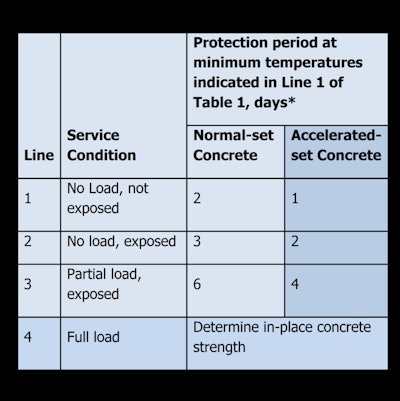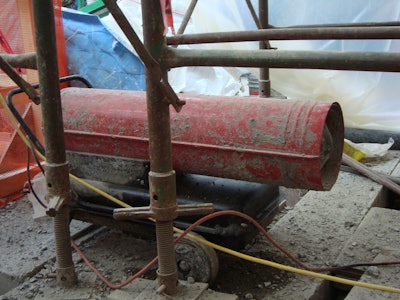
There are three primary objectives for cold weather concreting: 1) protect the newly placed concrete from early-age freezing, 2) protect concrete to ensure adequate strength development, and 3) protect concrete from thermal shock and cracking at the end of the protection period.
According to ACI 306 Guide to Cold Weather Concreting, cold weather exists when the air temperature has fallen to, or is expected to fall below, 40° F during the protection period. The protection period is the time required to prevent concrete from being affected by exposure to cold weather. (See sidebar for more about this definition.)
Protect from early-age freezing
If newly placed concrete freezes, immediate and permanent damage can occur; subsequent curing will not restore the concrete’s properties. Damage occurs because water expands 9 percent in volume when it freezes. The formation of ice crystals and resulting paste expansion can reduce the compressive strength and increase the porosity of the hardened concrete. Strength reductions up to 50 percent can occur if freezing takes place in the first few hours after concrete placement or before the concrete attains a compressive strength of approximately 500 psi.
 This sidewalk was placed in early winter in Wyoming and froze while it was fresh, forming ice casts marked by dark radiating lines. The sidewalk exhibited extensive scaling and deterioration in its first year of service. Scale is in millimeters.
This sidewalk was placed in early winter in Wyoming and froze while it was fresh, forming ice casts marked by dark radiating lines. The sidewalk exhibited extensive scaling and deterioration in its first year of service. Scale is in millimeters.
Newly placed concrete must be protected from early-age freezing until the amount of mixing water or the degree of saturation has been sufficiently reduced by the process of hydration, the term used to describe the chemical reaction between the portland cement or cementitious materials and water. During hydration, the degree of saturation continually decreases as the mixing water combines with the cementitious materials and the concrete stiffens and hardens. Due to the hydration process, the amount of available mix water to form ice crystals continually decreases so there is less risk of permanent damage if the concrete freezes.
When there are no external sources of water, the critical degree of saturation so a single cycle of freezing does not permanently damage the concrete occurs when the concrete attains a strength of approximately 500 psi. At specified curing temperatures, well-portioned concrete mixtures should attain this strength within 24 to 48 hours. Therefore, it is critical that newly placed concrete be protected from freezing for the first 24 to 48 hours or until the concrete attains a strength of approximately 500 psi.
When the concrete attains a strength of at least 500 psi, it can tolerate one freeze-and-thaw cycle without damage if the concrete is air-entrained and not exposed to an external water source. For exposure to repeated cycles of freezing and thawing, new concrete should attain a strength of at least 3,500 psi, or 4,000 psi if it will be exposed to repeated cycles of freezing and thawing and deicing chemicals. To avoid early-age damage from cold weather, protect the concrete as soon as practicable after placing, consolidation and finishing.
Temperature and protection periods

According to Line 1 in Tables 1 and 2, the minimum concrete temperature as placed and maintained is 55° F for a concrete section with a minimum dimension of 12-inches and the minimum protection periods are two and one days for normal-set and accelerated-set concrete mixtures, respectively. Line 1 in Tables 1 and 2 provides minimum concrete temperatures and durations to ensure the mixing water in the newly placed concrete does not freeze.

Protect to ensure adequate strength gain
The rate of concrete hardening and strength gain depends on the temperature of the concrete. Low concrete temperatures decrease the rate of hydration and subsequently retard the rate of strength gain. To ensure newly placed concrete develops the required strength for safe removal of forms, shores and reshores, and safe loading of the structure during and after construction, adequate concrete temperatures must be maintained during the protection or curing period.
When there are early-age strength requirements, use Table 2 to determine the minimum protection periods for the following service conditions: 1) no load, not exposed; 2) no load, exposed; 3) partial load, exposed; and 4) full load. Depending on the load requirements and exposure conditions, it may be necessary to extend the protection period beyond the minimums listed in Line 1 in Table 2
“No load, not exposed” means the concrete element will not carry significant loads during the protection period and will not be exposed to freezing conditions in service. “No load, exposed” means the concrete element will not carry significant loads during the protection period and will be exposed to freezing conditions in service. “Partial load, exposed” means the concrete element will carry loads that are less than the available early-age load capacity during the protection period and will be exposed to freezing conditions in service. Elements that require reshoring to carry construction loads before attaining the specified strength have a service condition of “Full load” and typically require the contractor to determine in-place concrete strengths.
For example, the service condition for a 6-inch thick, concrete parking lot pavement at a commercial building site that will be exposed to winter conditions and cast from accelerated-set concrete would be “Partial load, exposed” and require a minimum protection period of 4 days. According to Line 1 of Table 1, the minimum concrete temperature of 55° F should be maintained for the four-day protection period.
 "No load, exposed" means the concrete element will not carry significant loads during the protection period and will be exposed to freezing conditions in service.
"No load, exposed" means the concrete element will not carry significant loads during the protection period and will be exposed to freezing conditions in service.
Protection methods
Methods to maintain the minimum temperatures as placed and maintained as shown in Line 1 of Table 1 include insulation (blankets and boards), heating systems such as electric blankets and hydronic heating systems, unheated or heated enclosures, or a combination of the methods.
Insulation is the most economical means of maintaining adequate cure temperatures because this method takes advantage of the heat of hydration, or the heat generated by the chemical reaction between the cement and water. Depending on the mass of the concrete, cement content and ambient conditions (i.e., air temperatures and wind), insulation can typically maintain adequate cure temperatures by capturing the heat of hydration.
Cover the concrete with blankets as soon as possible to capture as much of the heat of hydration as possible. Capturing the early heat of hydration will help maintain the cure temperature but will also help to promote hydration which in turn produces additional heat. Be sure to protect corners and surfaces since these areas are the most susceptible to early-age freezing and damage.
For extreme winter conditions, sometimes the heat of hydration is not sufficient to maintain adequate cure temperatures and supplementary heat is required. Additional heat can be supplied using electric concrete blankets, hydronic heaters, and heated enclosures. Of course, using supplementary heat increases the cost of cold weather concreting.
 When using combustion heaters for heating enclosures, ensure proper exhaust ventilation to prevent carbonization of concrete and carbon monoxide safety issues for workers.
When using combustion heaters for heating enclosures, ensure proper exhaust ventilation to prevent carbonization of concrete and carbon monoxide safety issues for workers.
Hydronic heaters circulate a heated glycol-water liquid through a system of heat transfer hoses placed on the concrete or forms. Typically, the hoses are covered with concrete insulation blankets to capture and hold the heat.
Combustion heaters for heating enclosures should be vented and not positioned to directly heat or dry out the concrete. Fresh concrete surfaces exposed to carbon dioxide from unvented combustion heaters can be damaged by carbonation of the concrete. Carbonation occurs when carbon dioxide reacts with cement hydration products creating soft and chalky surfaces. Unvented combustion heaters also produce carbon monoxide. Of course, high concentration levels of these gases are hazardous to workers.
Protect from thermal shock and cracking
 Protect concrete surfaces and corners from cold weather by ensuring all surfaces are covered.
Protect concrete surfaces and corners from cold weather by ensuring all surfaces are covered.
Preplanning is the key to successful cold weather concreting. When developing your next cold weather concreting plan, consider the three primary objectives: protect the concrete from early-age freezing, protect to ensure adequate strength gain, and protect from thermal shock and cracking.
References
ACI 301-10 Specifications for Structural Concrete, American Concrete Institute, www.concrete.org
ACI 306R-10 Guide to Cold Weather Concreting, American Concrete Institute, www.concrete.org
Kosmatka, S.H. and Wilson, M.L., Design and Control of Concrete Mixtures, 15th Edition, 2011, Portland Cement Association, www.cement.org



























